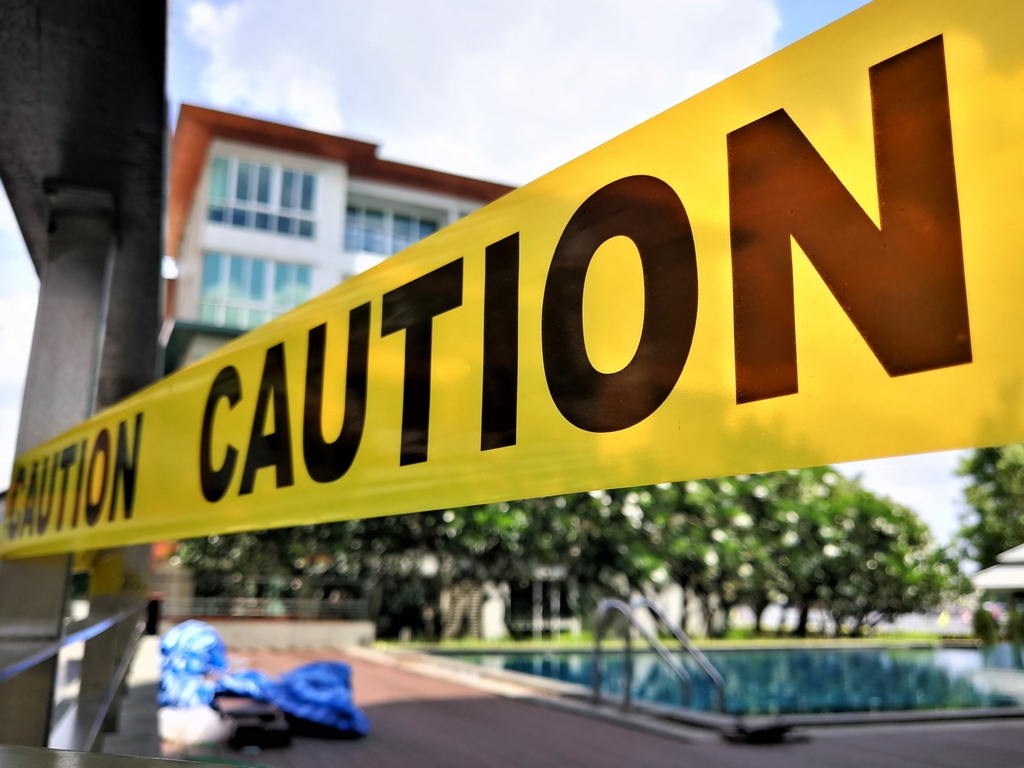Caution: Don’t Forget the Tape


For all of the complexity and sophistication of watershape construction projects, some of the most important considerations are also the simplest. Chief among those, says Scott Cohen, using caution tape to help prevent jobsite injuries is an essential measure, but also one that can be all too easy to forget.
By Scott Cohen
In the bustling environment of a construction site, safety transcends mere procedure — it is a fundamental cornerstone that protects lives, prevents injury and mitigates risks, both physical and litigious. It’s fair to say that jobsite safety is nothing less than a professional responsibility of the highest possible order.
Among the myriad of safety measures, one seemingly modest, yet-pivotal tool stands out: caution tape.
Also known as barrier tape or warning tape, this familiar and vibrant marker serves as a critical visual barrier that is effective in safeguarding workers and residents from construction hazards. From the watershaping perspective, it’s simple commonsense: when your work involves digging large holes where your clients live, the significance of caution tape cannot be overstated.
TOP OF MIND
A contractor’s primary responsibility extends far beyond the mere progression of a project; it encompasses the safety and well-being of the residents, employees, subcontractors, and even casual visitors. This duty of care is paramount because construction sites are replete with hazards ranging from open excavations and wet concrete to unstable structures and scattered debris.
Caution tape acts as a silent sentinel, delineating areas where danger exists, thereby preventing unintentional entry into hazardous zones. It works because when made aware of an immediate hazard, most people choose to avoid injury. Yes, a caution tape boundary can be easily crossed, but the vast majority of us are not that careless.
Stating the obvious, swimming pools and other types of watershapes typically involve excavations that are several feet deep. Not only are we digging pools, we’re also digging trenches and holes for everything from footings for outdoor kitchens to walls and pilaster, and countless other types of structures. It’s easy to make an assumption the people will know to stay away from physical hazards, but these are people’s homes. The unexpected can and sometimes will happen.
That’s why the absence of caution tape is not merely an oversight; it’s a breach of the fundamental safety protocols that govern construction sites, of all types, pools and otherwise. Without it, people are left vulnerable to accidents and injuries, which can range from minor to life-threatening. The repercussions of such incidents extend beyond physical harm, impacting the mental well-being of the injured and potentially leading to legal and financial consequences for contractors.
Moreover, the use of caution tape is a visual testament to a contractor’s commitment to safety and professionalism. It reflects a proactive approach to hazard management and demonstrates a respect for the well-being of all site occupants. This commitment can significantly enhance a contractor’s reputation, fostering trust among clients and collaborators alike.
In today’s litigious society, the role of a construction defect expert witness has become increasingly crucial. In that role, professionals like me often highlight the importance of preemptive safety measures, including the use of caution tape, in preventing accidents and mitigating risks. Insights into safety standards can be instrumental in legal cases, underscoring the critical nature of adhering to safety protocols to avoid construction defects and the resulting repercussions.
Caution tape is a very inexpensive way to show your concern for others. Its presence is a non-negotiable aspect of site safety, serving as a constant reminder of the potential dangers that construction sites pose.
TAPE BASICS
Caution tape is designed to catch the eye for three basic purposes:
- Safety and Warning: Caution tape is primarily used to alert people to potential hazards, such as construction sites, accident scenes, or areas where there is a risk of falling, electrical hazards, or chemical exposure.
- Perimeter Marking: It is also used to delineate specific areas, marking the boundary for a temporary restricted zone, such as a crime scene or during public events to guide crowd control.
- Access Control: In both public and private settings, it serves to restrict access to areas for safety, security, or privacy reasons.
Caution tape is typically made from durable, weather-resistant materials like polyethylene, vinyl, or nylon. This ensures it can withstand various environmental conditions without tearing or fading quickly.
Bright colors and bold text are key features. The tape is often manufactured in high-visibility colors like yellow, orange, or red, with black text to ensure it stands out and can be seen and read from a distance.
While there’s no universal standard, certain colors are commonly used for specific purposes. For example, yellow is often used for caution in general, while red might indicate a prohibited or dangerous area. In some countries or industries, the color coding can be regulated to maintain consistency. (See below for OSHA tape color specifications.)
Likewise, there are no universal standards for the size of the tape or the text on it, but clarity and visibility are paramount. The tape is typically available in various widths, ranging from 2 to 6 inches, to ensure visibility from a distance.
It’s important to place caution tape in a manner that clearly communicates the intended message and does not create additional hazards, such as tripping risks. Caution tape is generally intended for temporary situations. Long-term or permanent hazards should be addressed with more durable signage and barriers. Considering the environmental impact, some manufacturers offer biodegradable options to minimize waste.
OSHA RULES
The Occupational Safety and Health Administration (OSHA) plays a crucial role in ensuring workplace safety, including the use of visual warnings like caution tape to mark physical hazards. OSHA’s guidelines for marking physical hazards are designed to protect workers by providing clear, visible warnings to prevent accidents and injuries. Here’s an overview of OSHA’s guidelines related to marking physical hazards:
First, OSHA has established color codes for marking physical hazards, with specific colors designated for different types of warnings:
- Yellow is commonly used for caution and marks physical hazards that could result in slipping, tripping, falling, striking against, or being struck by objects.
- Red indicates a prohibition, stop, or fire-related hazards. It’s used for fire protection equipment, flammable liquids containers, and emergency switches.
- Orange is used for warning against dangerous parts of machinery or energized equipment which may cut, crush, or otherwise injure.
- Other colors such as blue, green, and black are used for information, safety equipment, and housekeeping signs.
OSHA standard 1910.144(a) requires that hazard markings be placed near the hazard and in a location where they are clearly visible to anyone who is approaching or in the vicinity of the hazard. This ensures that workers can easily see and understand the risks associated with a particular area or piece of equipment.
Caution tape typically falls under this regulation, especially when used to mark areas that may expose workers to minor or moderate injury risks. The standard emphasizes the importance of using yellow for caution (with black lettering for text, if any) and red for fire-related hazards.
OSHA provides sector-specific guidelines for construction, general industry, maritime, and agricultural operations. For example, in construction, OSHA standard 1926.200(g)(2) mandates the use of signs, signals, and barricades where workers are exposed to hazards from vehicles, equipment, or falling objects, which can include the use of caution tape to delineate such areas.
OSHA requires that all safety markings, including caution tape, be maintained in good condition to ensure their effectiveness. This means they must be replaced or repaired if they become faded, torn, or otherwise compromised in their ability to provide a clear warning.
While OSHA provides comprehensive guidelines for marking physical hazards, it’s essential for businesses to stay updated with any specific standards applicable to their industry or locality, as regulations can vary. Implementing these safety measures not only complies with OSHA regulations but also significantly contributes to creating a safer work environment.
For businesses like ours, The Green Scene, incorporating OSHA’s guidelines into workplace safety protocols can help prevent accidents during landscaping and construction projects, ensuring both employee safety and regulatory compliance.
EXCAVATION DEPTH
For projects involving excavation and the creation of footings for structures, or vessels for bodies of water, OSHA has specific regulations that address safety concerns and permit requirements. Although the use of caution tape is a key part of those requirements, the regulations go much further.
The depth of an excavation and the need for a specific permit from OSHA typically relate to the hazards associated with trenching and excavation work.
Any trench that is deeper than 5 feet (1.52 meters) requires protective systems to prevent cave-ins, except when the excavation is made entirely in stable rock. OSHA’s requirement for a protective system is based on the depth and conditions of the excavation and is not directly tied to the issuance of a permit. However, when excavations reach or exceed this depth, the complexity of ensuring safety increases, necessitating careful planning and potentially additional measures that might include obtaining permits for certain types of work or safety measures.
OSHA’s “Permit-Required Confined Spaces” (29 CFR 1926.1200) standard could be relevant if the footing excavation creates a confined space situation. This regulation requires employers to evaluate the work site to determine if any spaces are permit-required confined spaces, according to the definition provided by OSHA.
While the standard focuses more on the nature of the confined space rather than the depth of the excavation, deep footings could potentially create conditions that meet the criteria for a permit-required confined space (e.g., a space with limited entry and exit that is not designed for continuous occupancy and has potential for hazardous atmosphere or other serious safety or health hazards).
For projects involving deep excavations, including deep footings, it’s crucial to:
- Implement protective systems for excavations deeper than 5 feet unless the excavation is in stable rock.
- Conduct a hazard assessment if the excavation could potentially create a confined space, to determine if a permit is required.
- Follow all relevant OSHA standards for trenching and excavation (29 CFR 1926 Subpart P), including requirements for protective systems, access and egress, and inspections.
To get the most accurate and up-to-date information, consulting OSHA’s official guidelines and potentially contacting the local OSHA office for specific inquiries is recommended. Regulations may have nuances based on the project’s specific context, including the site’s geographical location, the soil type, and the proximity to other structures or hazards.
Scott Cohen is a nationally respected expert witness in pool-construction defect cases. He currently serves as the chairman of the California Pool and Spa Association. Cohen is a “garden artisan” and president of Green Scene Landscaping & Pools, a watershape design and construction firm based in Chatsworth, CA. A widely published author and popular speaker, Cohen is known for his gardens that combine outdoor living with inspired artistic details.











